CMBS Analysis: Structure, Benefits, and Investment Strategies Report
VerifiedAdded on 2022/09/14
|9
|1777
|11
Report
AI Summary
This report provides a detailed analysis of Commercial Mortgage-Backed Securities (CMBS). It begins with an introduction to CMBS, highlighting their unique features and role in providing liquidity to commercial lenders and real estate investors. The report explains the structure of CMBS, including how they are backed by commercial property mortgages, and the process of loan securitization. It then delves into credit tranching, explaining how CMBS are divided into tranches with varying risk levels to protect investors, and the diversification benefits of CMBS compared to other asset classes. The report also compares CMBS with corporate bonds and provides data on their spreads. Finally, it concludes that CMBS play a valuable role in fixed-income portfolios and can be a better investment option than other risky corporate bonds. The report includes tables and charts to illustrate key concepts, and references several academic sources.
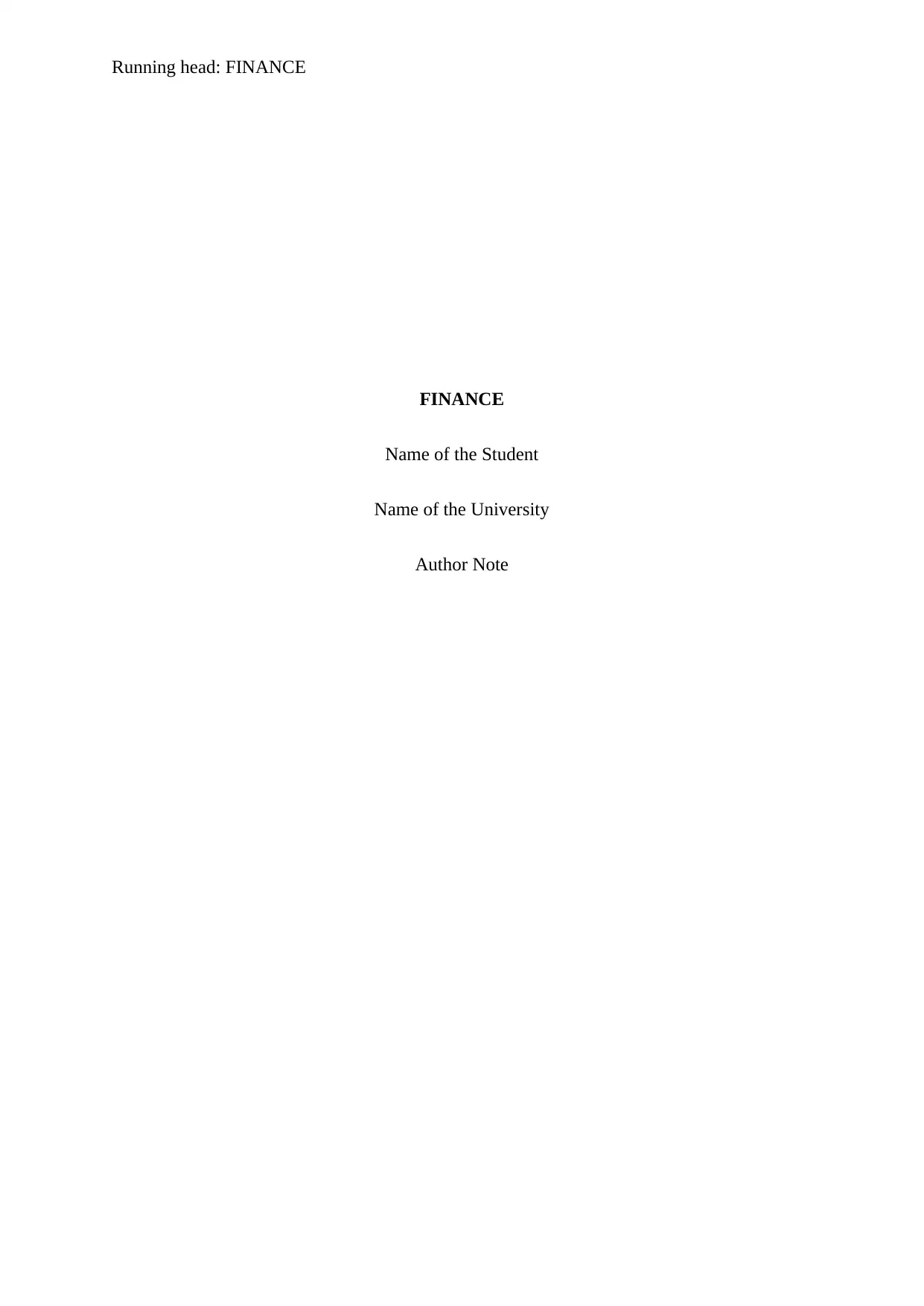
Running head: FINANCE
FINANCE
Name of the Student
Name of the University
Author Note
FINANCE
Name of the Student
Name of the University
Author Note
Paraphrase This Document
Need a fresh take? Get an instant paraphrase of this document with our AI Paraphraser
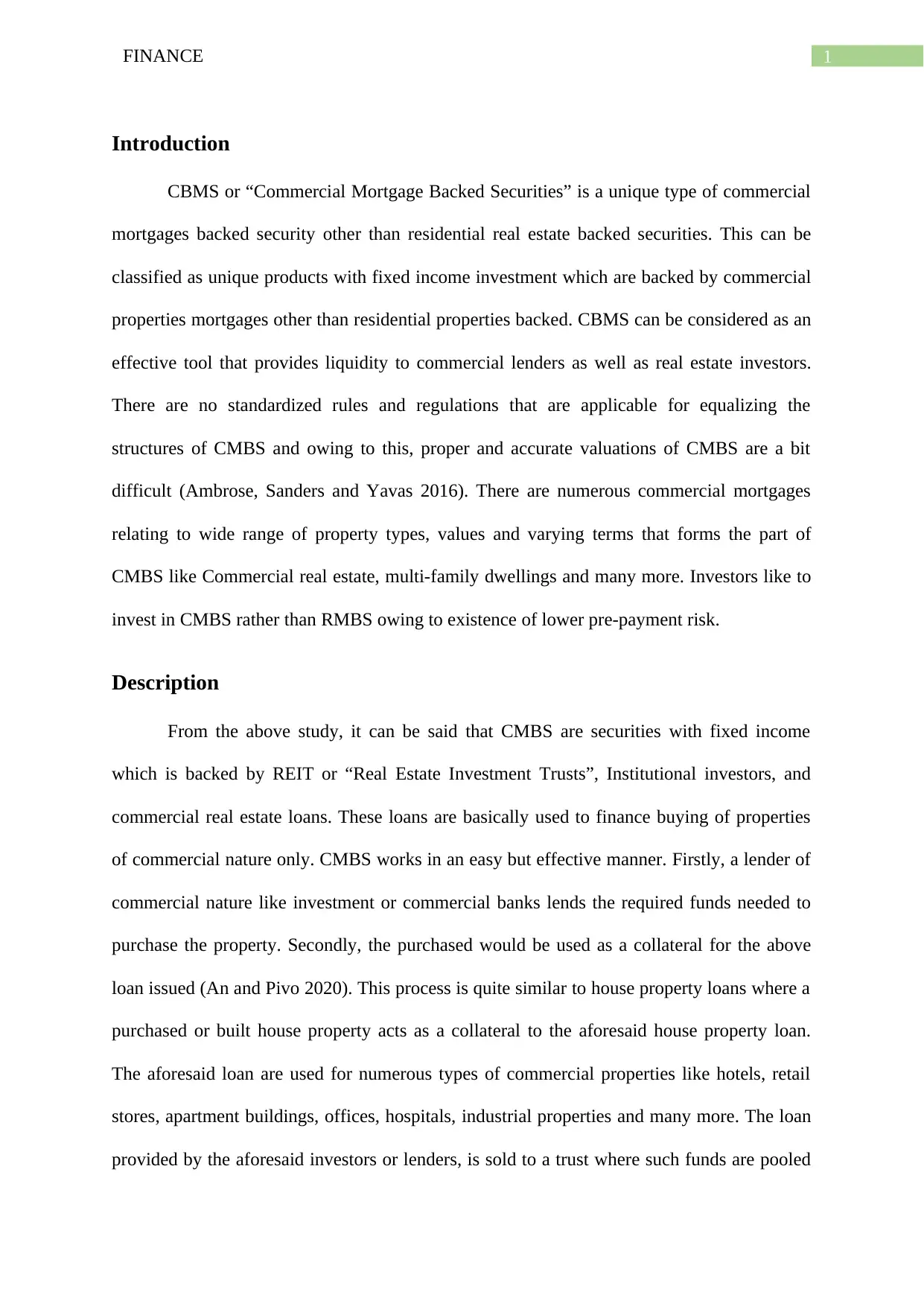
1FINANCE
Introduction
CBMS or “Commercial Mortgage Backed Securities” is a unique type of commercial
mortgages backed security other than residential real estate backed securities. This can be
classified as unique products with fixed income investment which are backed by commercial
properties mortgages other than residential properties backed. CBMS can be considered as an
effective tool that provides liquidity to commercial lenders as well as real estate investors.
There are no standardized rules and regulations that are applicable for equalizing the
structures of CMBS and owing to this, proper and accurate valuations of CMBS are a bit
difficult (Ambrose, Sanders and Yavas 2016). There are numerous commercial mortgages
relating to wide range of property types, values and varying terms that forms the part of
CMBS like Commercial real estate, multi-family dwellings and many more. Investors like to
invest in CMBS rather than RMBS owing to existence of lower pre-payment risk.
Description
From the above study, it can be said that CMBS are securities with fixed income
which is backed by REIT or “Real Estate Investment Trusts”, Institutional investors, and
commercial real estate loans. These loans are basically used to finance buying of properties
of commercial nature only. CMBS works in an easy but effective manner. Firstly, a lender of
commercial nature like investment or commercial banks lends the required funds needed to
purchase the property. Secondly, the purchased would be used as a collateral for the above
loan issued (An and Pivo 2020). This process is quite similar to house property loans where a
purchased or built house property acts as a collateral to the aforesaid house property loan.
The aforesaid loan are used for numerous types of commercial properties like hotels, retail
stores, apartment buildings, offices, hospitals, industrial properties and many more. The loan
provided by the aforesaid investors or lenders, is sold to a trust where such funds are pooled
Introduction
CBMS or “Commercial Mortgage Backed Securities” is a unique type of commercial
mortgages backed security other than residential real estate backed securities. This can be
classified as unique products with fixed income investment which are backed by commercial
properties mortgages other than residential properties backed. CBMS can be considered as an
effective tool that provides liquidity to commercial lenders as well as real estate investors.
There are no standardized rules and regulations that are applicable for equalizing the
structures of CMBS and owing to this, proper and accurate valuations of CMBS are a bit
difficult (Ambrose, Sanders and Yavas 2016). There are numerous commercial mortgages
relating to wide range of property types, values and varying terms that forms the part of
CMBS like Commercial real estate, multi-family dwellings and many more. Investors like to
invest in CMBS rather than RMBS owing to existence of lower pre-payment risk.
Description
From the above study, it can be said that CMBS are securities with fixed income
which is backed by REIT or “Real Estate Investment Trusts”, Institutional investors, and
commercial real estate loans. These loans are basically used to finance buying of properties
of commercial nature only. CMBS works in an easy but effective manner. Firstly, a lender of
commercial nature like investment or commercial banks lends the required funds needed to
purchase the property. Secondly, the purchased would be used as a collateral for the above
loan issued (An and Pivo 2020). This process is quite similar to house property loans where a
purchased or built house property acts as a collateral to the aforesaid house property loan.
The aforesaid loan are used for numerous types of commercial properties like hotels, retail
stores, apartment buildings, offices, hospitals, industrial properties and many more. The loan
provided by the aforesaid investors or lenders, is sold to a trust where such funds are pooled
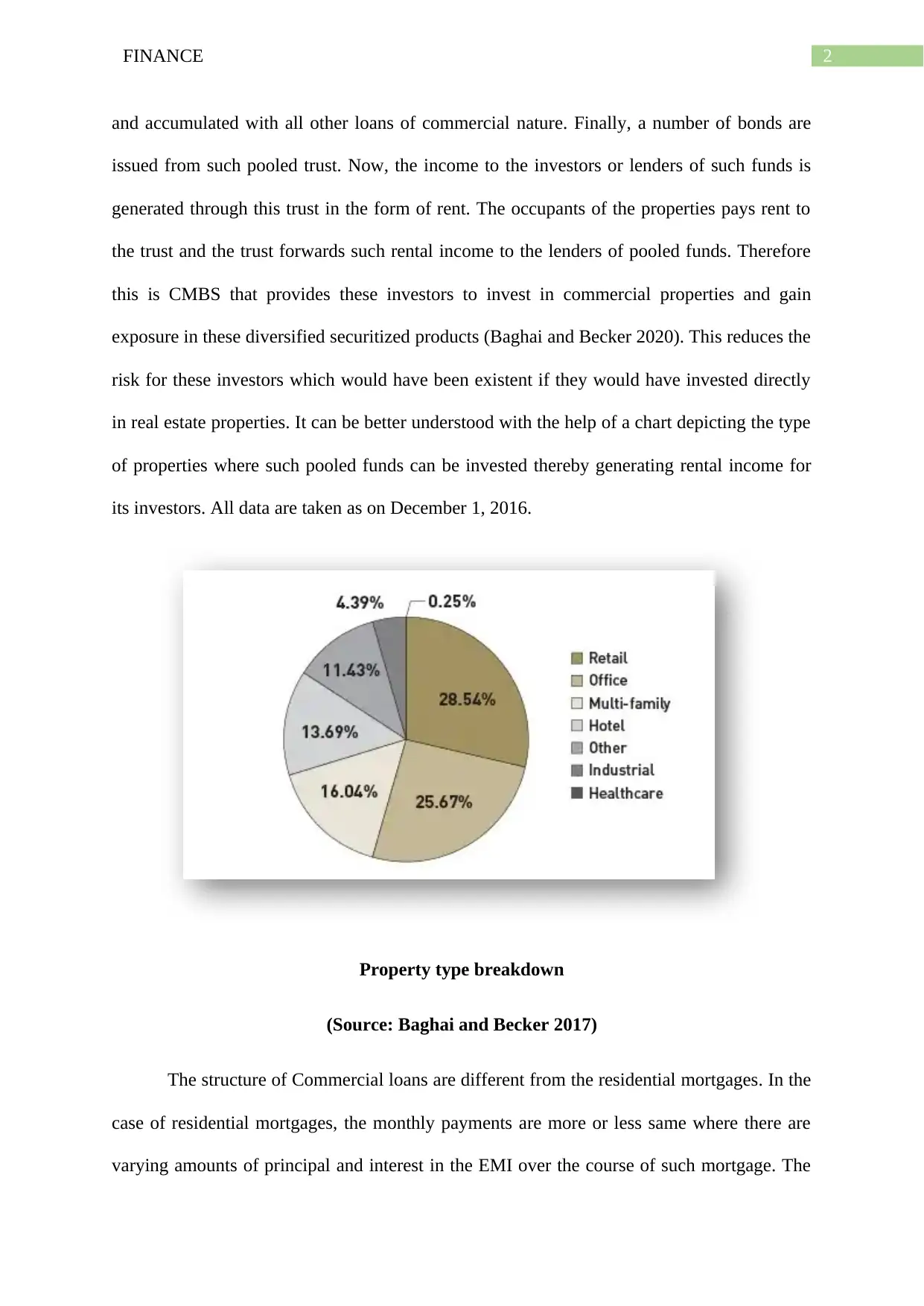
2FINANCE
and accumulated with all other loans of commercial nature. Finally, a number of bonds are
issued from such pooled trust. Now, the income to the investors or lenders of such funds is
generated through this trust in the form of rent. The occupants of the properties pays rent to
the trust and the trust forwards such rental income to the lenders of pooled funds. Therefore
this is CMBS that provides these investors to invest in commercial properties and gain
exposure in these diversified securitized products (Baghai and Becker 2020). This reduces the
risk for these investors which would have been existent if they would have invested directly
in real estate properties. It can be better understood with the help of a chart depicting the type
of properties where such pooled funds can be invested thereby generating rental income for
its investors. All data are taken as on December 1, 2016.
Property type breakdown
(Source: Baghai and Becker 2017)
The structure of Commercial loans are different from the residential mortgages. In the
case of residential mortgages, the monthly payments are more or less same where there are
varying amounts of principal and interest in the EMI over the course of such mortgage. The
and accumulated with all other loans of commercial nature. Finally, a number of bonds are
issued from such pooled trust. Now, the income to the investors or lenders of such funds is
generated through this trust in the form of rent. The occupants of the properties pays rent to
the trust and the trust forwards such rental income to the lenders of pooled funds. Therefore
this is CMBS that provides these investors to invest in commercial properties and gain
exposure in these diversified securitized products (Baghai and Becker 2020). This reduces the
risk for these investors which would have been existent if they would have invested directly
in real estate properties. It can be better understood with the help of a chart depicting the type
of properties where such pooled funds can be invested thereby generating rental income for
its investors. All data are taken as on December 1, 2016.
Property type breakdown
(Source: Baghai and Becker 2017)
The structure of Commercial loans are different from the residential mortgages. In the
case of residential mortgages, the monthly payments are more or less same where there are
varying amounts of principal and interest in the EMI over the course of such mortgage. The
⊘ This is a preview!⊘
Do you want full access?
Subscribe today to unlock all pages.

Trusted by 1+ million students worldwide
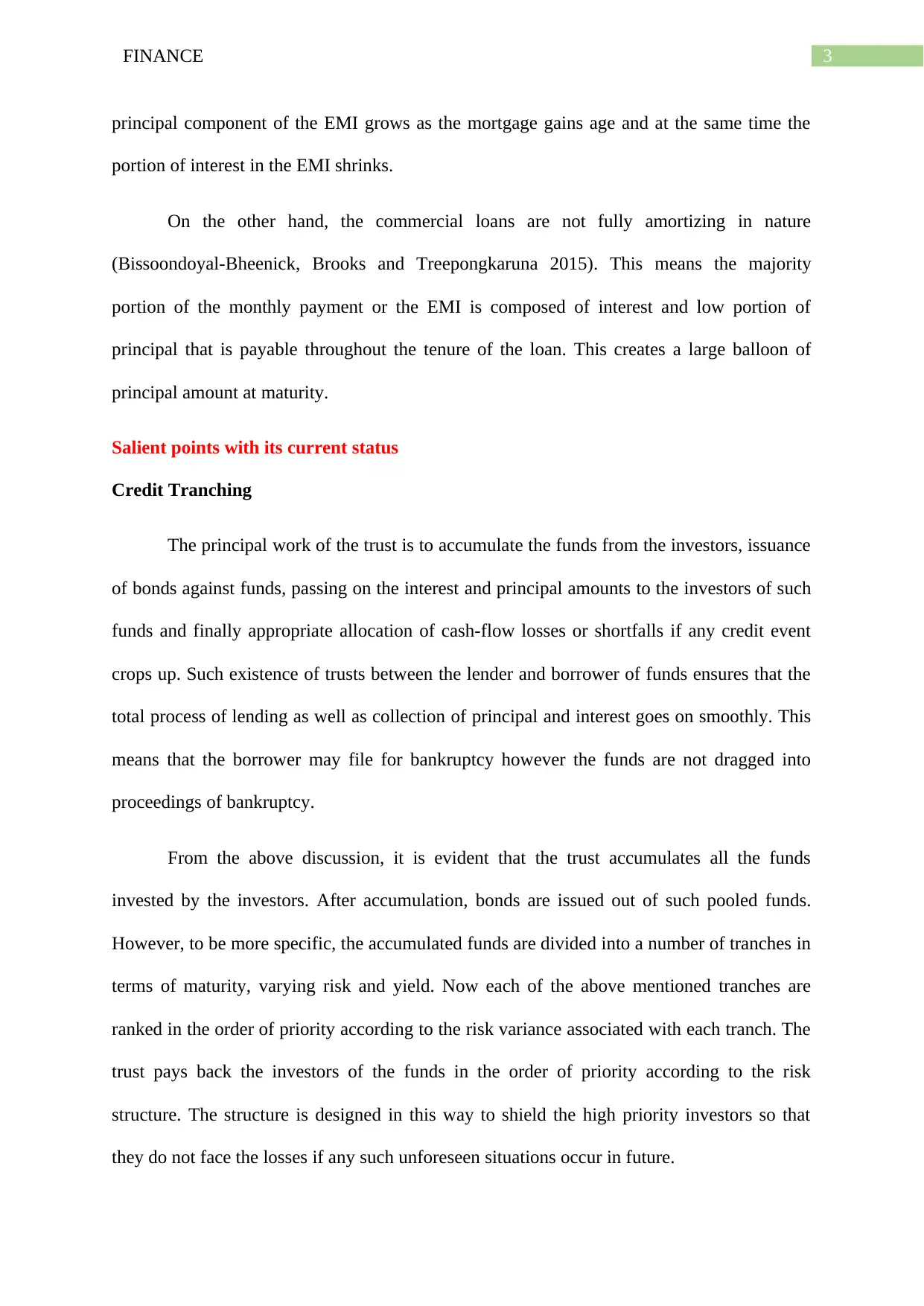
3FINANCE
principal component of the EMI grows as the mortgage gains age and at the same time the
portion of interest in the EMI shrinks.
On the other hand, the commercial loans are not fully amortizing in nature
(Bissoondoyal-Bheenick, Brooks and Treepongkaruna 2015). This means the majority
portion of the monthly payment or the EMI is composed of interest and low portion of
principal that is payable throughout the tenure of the loan. This creates a large balloon of
principal amount at maturity.
Salient points with its current status
Credit Tranching
The principal work of the trust is to accumulate the funds from the investors, issuance
of bonds against funds, passing on the interest and principal amounts to the investors of such
funds and finally appropriate allocation of cash-flow losses or shortfalls if any credit event
crops up. Such existence of trusts between the lender and borrower of funds ensures that the
total process of lending as well as collection of principal and interest goes on smoothly. This
means that the borrower may file for bankruptcy however the funds are not dragged into
proceedings of bankruptcy.
From the above discussion, it is evident that the trust accumulates all the funds
invested by the investors. After accumulation, bonds are issued out of such pooled funds.
However, to be more specific, the accumulated funds are divided into a number of tranches in
terms of maturity, varying risk and yield. Now each of the above mentioned tranches are
ranked in the order of priority according to the risk variance associated with each tranch. The
trust pays back the investors of the funds in the order of priority according to the risk
structure. The structure is designed in this way to shield the high priority investors so that
they do not face the losses if any such unforeseen situations occur in future.
principal component of the EMI grows as the mortgage gains age and at the same time the
portion of interest in the EMI shrinks.
On the other hand, the commercial loans are not fully amortizing in nature
(Bissoondoyal-Bheenick, Brooks and Treepongkaruna 2015). This means the majority
portion of the monthly payment or the EMI is composed of interest and low portion of
principal that is payable throughout the tenure of the loan. This creates a large balloon of
principal amount at maturity.
Salient points with its current status
Credit Tranching
The principal work of the trust is to accumulate the funds from the investors, issuance
of bonds against funds, passing on the interest and principal amounts to the investors of such
funds and finally appropriate allocation of cash-flow losses or shortfalls if any credit event
crops up. Such existence of trusts between the lender and borrower of funds ensures that the
total process of lending as well as collection of principal and interest goes on smoothly. This
means that the borrower may file for bankruptcy however the funds are not dragged into
proceedings of bankruptcy.
From the above discussion, it is evident that the trust accumulates all the funds
invested by the investors. After accumulation, bonds are issued out of such pooled funds.
However, to be more specific, the accumulated funds are divided into a number of tranches in
terms of maturity, varying risk and yield. Now each of the above mentioned tranches are
ranked in the order of priority according to the risk variance associated with each tranch. The
trust pays back the investors of the funds in the order of priority according to the risk
structure. The structure is designed in this way to shield the high priority investors so that
they do not face the losses if any such unforeseen situations occur in future.
Paraphrase This Document
Need a fresh take? Get an instant paraphrase of this document with our AI Paraphraser
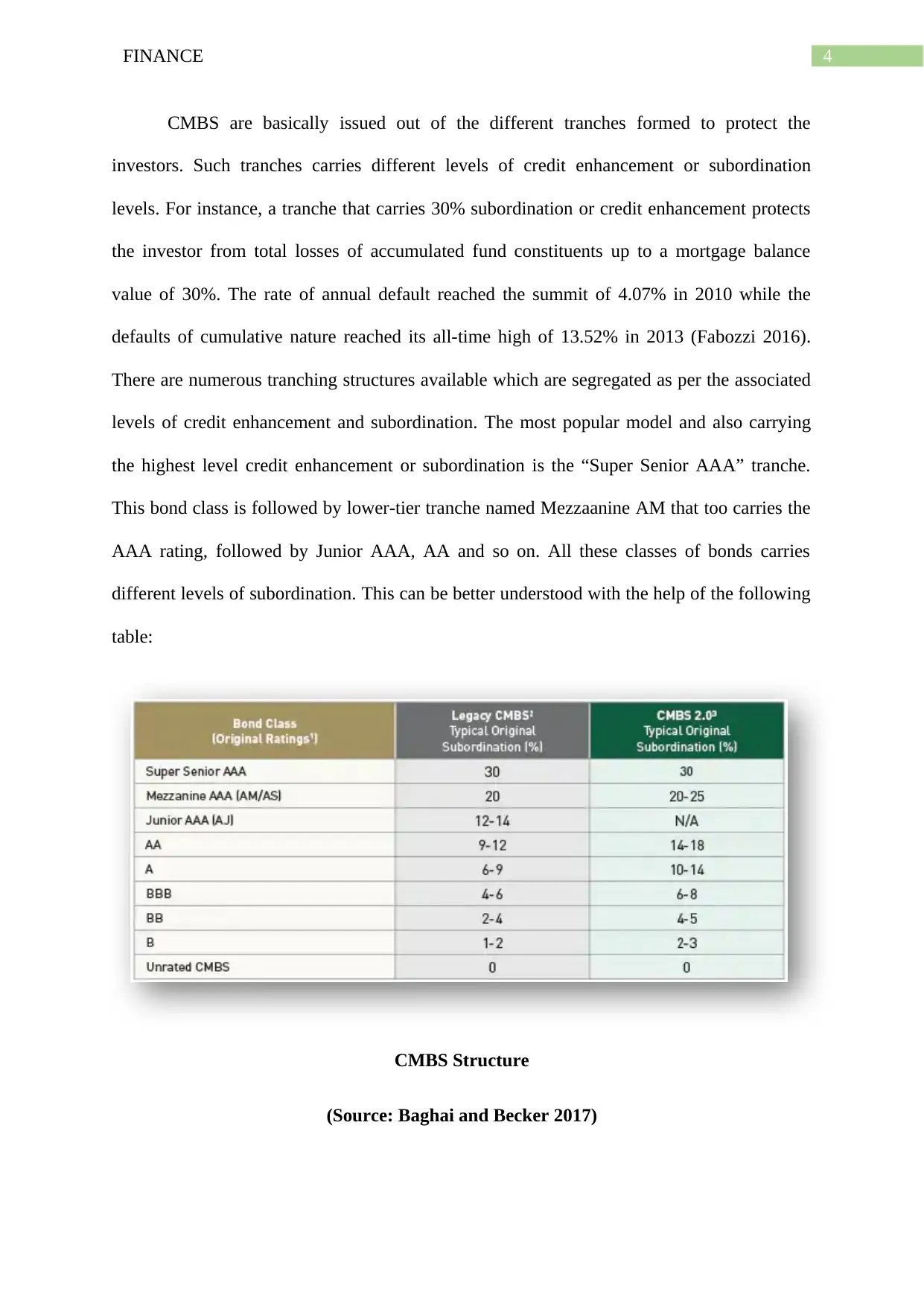
4FINANCE
CMBS are basically issued out of the different tranches formed to protect the
investors. Such tranches carries different levels of credit enhancement or subordination
levels. For instance, a tranche that carries 30% subordination or credit enhancement protects
the investor from total losses of accumulated fund constituents up to a mortgage balance
value of 30%. The rate of annual default reached the summit of 4.07% in 2010 while the
defaults of cumulative nature reached its all-time high of 13.52% in 2013 (Fabozzi 2016).
There are numerous tranching structures available which are segregated as per the associated
levels of credit enhancement and subordination. The most popular model and also carrying
the highest level credit enhancement or subordination is the “Super Senior AAA” tranche.
This bond class is followed by lower-tier tranche named Mezzaanine AM that too carries the
AAA rating, followed by Junior AAA, AA and so on. All these classes of bonds carries
different levels of subordination. This can be better understood with the help of the following
table:
CMBS Structure
(Source: Baghai and Becker 2017)
CMBS are basically issued out of the different tranches formed to protect the
investors. Such tranches carries different levels of credit enhancement or subordination
levels. For instance, a tranche that carries 30% subordination or credit enhancement protects
the investor from total losses of accumulated fund constituents up to a mortgage balance
value of 30%. The rate of annual default reached the summit of 4.07% in 2010 while the
defaults of cumulative nature reached its all-time high of 13.52% in 2013 (Fabozzi 2016).
There are numerous tranching structures available which are segregated as per the associated
levels of credit enhancement and subordination. The most popular model and also carrying
the highest level credit enhancement or subordination is the “Super Senior AAA” tranche.
This bond class is followed by lower-tier tranche named Mezzaanine AM that too carries the
AAA rating, followed by Junior AAA, AA and so on. All these classes of bonds carries
different levels of subordination. This can be better understood with the help of the following
table:
CMBS Structure
(Source: Baghai and Becker 2017)
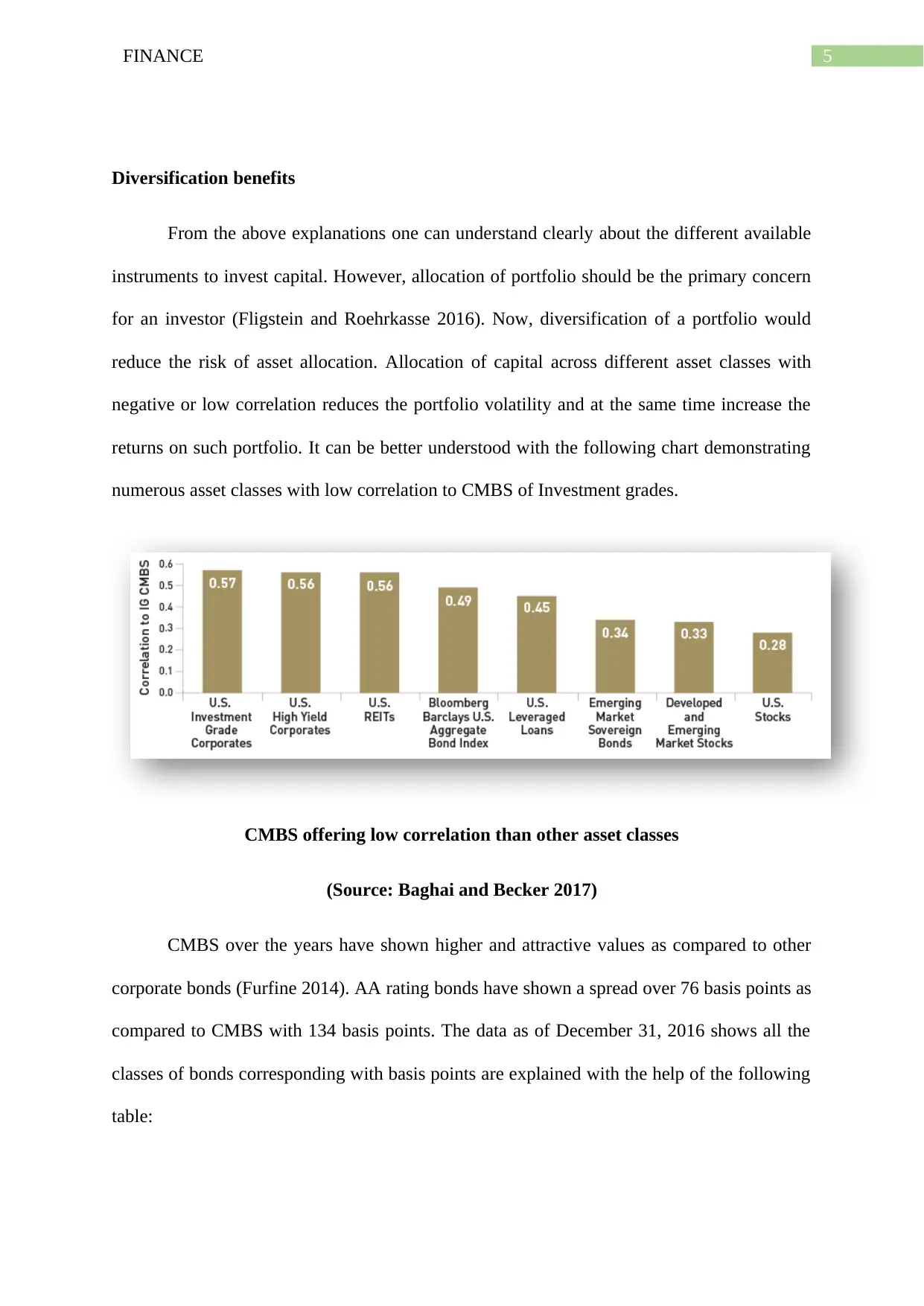
5FINANCE
Diversification benefits
From the above explanations one can understand clearly about the different available
instruments to invest capital. However, allocation of portfolio should be the primary concern
for an investor (Fligstein and Roehrkasse 2016). Now, diversification of a portfolio would
reduce the risk of asset allocation. Allocation of capital across different asset classes with
negative or low correlation reduces the portfolio volatility and at the same time increase the
returns on such portfolio. It can be better understood with the following chart demonstrating
numerous asset classes with low correlation to CMBS of Investment grades.
CMBS offering low correlation than other asset classes
(Source: Baghai and Becker 2017)
CMBS over the years have shown higher and attractive values as compared to other
corporate bonds (Furfine 2014). AA rating bonds have shown a spread over 76 basis points as
compared to CMBS with 134 basis points. The data as of December 31, 2016 shows all the
classes of bonds corresponding with basis points are explained with the help of the following
table:
Diversification benefits
From the above explanations one can understand clearly about the different available
instruments to invest capital. However, allocation of portfolio should be the primary concern
for an investor (Fligstein and Roehrkasse 2016). Now, diversification of a portfolio would
reduce the risk of asset allocation. Allocation of capital across different asset classes with
negative or low correlation reduces the portfolio volatility and at the same time increase the
returns on such portfolio. It can be better understood with the following chart demonstrating
numerous asset classes with low correlation to CMBS of Investment grades.
CMBS offering low correlation than other asset classes
(Source: Baghai and Becker 2017)
CMBS over the years have shown higher and attractive values as compared to other
corporate bonds (Furfine 2014). AA rating bonds have shown a spread over 76 basis points as
compared to CMBS with 134 basis points. The data as of December 31, 2016 shows all the
classes of bonds corresponding with basis points are explained with the help of the following
table:
⊘ This is a preview!⊘
Do you want full access?
Subscribe today to unlock all pages.

Trusted by 1+ million students worldwide
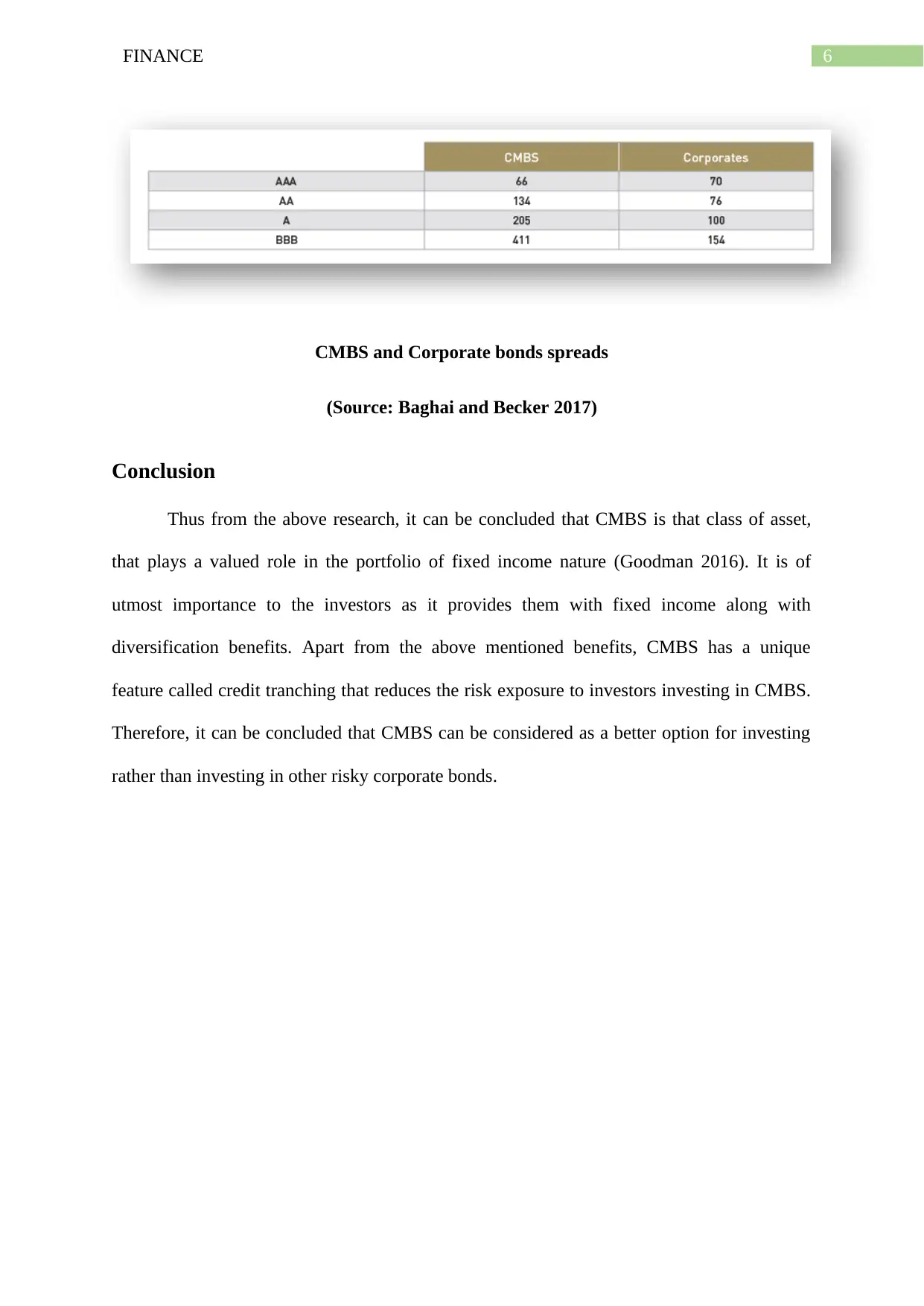
6FINANCE
CMBS and Corporate bonds spreads
(Source: Baghai and Becker 2017)
Conclusion
Thus from the above research, it can be concluded that CMBS is that class of asset,
that plays a valued role in the portfolio of fixed income nature (Goodman 2016). It is of
utmost importance to the investors as it provides them with fixed income along with
diversification benefits. Apart from the above mentioned benefits, CMBS has a unique
feature called credit tranching that reduces the risk exposure to investors investing in CMBS.
Therefore, it can be concluded that CMBS can be considered as a better option for investing
rather than investing in other risky corporate bonds.
CMBS and Corporate bonds spreads
(Source: Baghai and Becker 2017)
Conclusion
Thus from the above research, it can be concluded that CMBS is that class of asset,
that plays a valued role in the portfolio of fixed income nature (Goodman 2016). It is of
utmost importance to the investors as it provides them with fixed income along with
diversification benefits. Apart from the above mentioned benefits, CMBS has a unique
feature called credit tranching that reduces the risk exposure to investors investing in CMBS.
Therefore, it can be concluded that CMBS can be considered as a better option for investing
rather than investing in other risky corporate bonds.
Paraphrase This Document
Need a fresh take? Get an instant paraphrase of this document with our AI Paraphraser
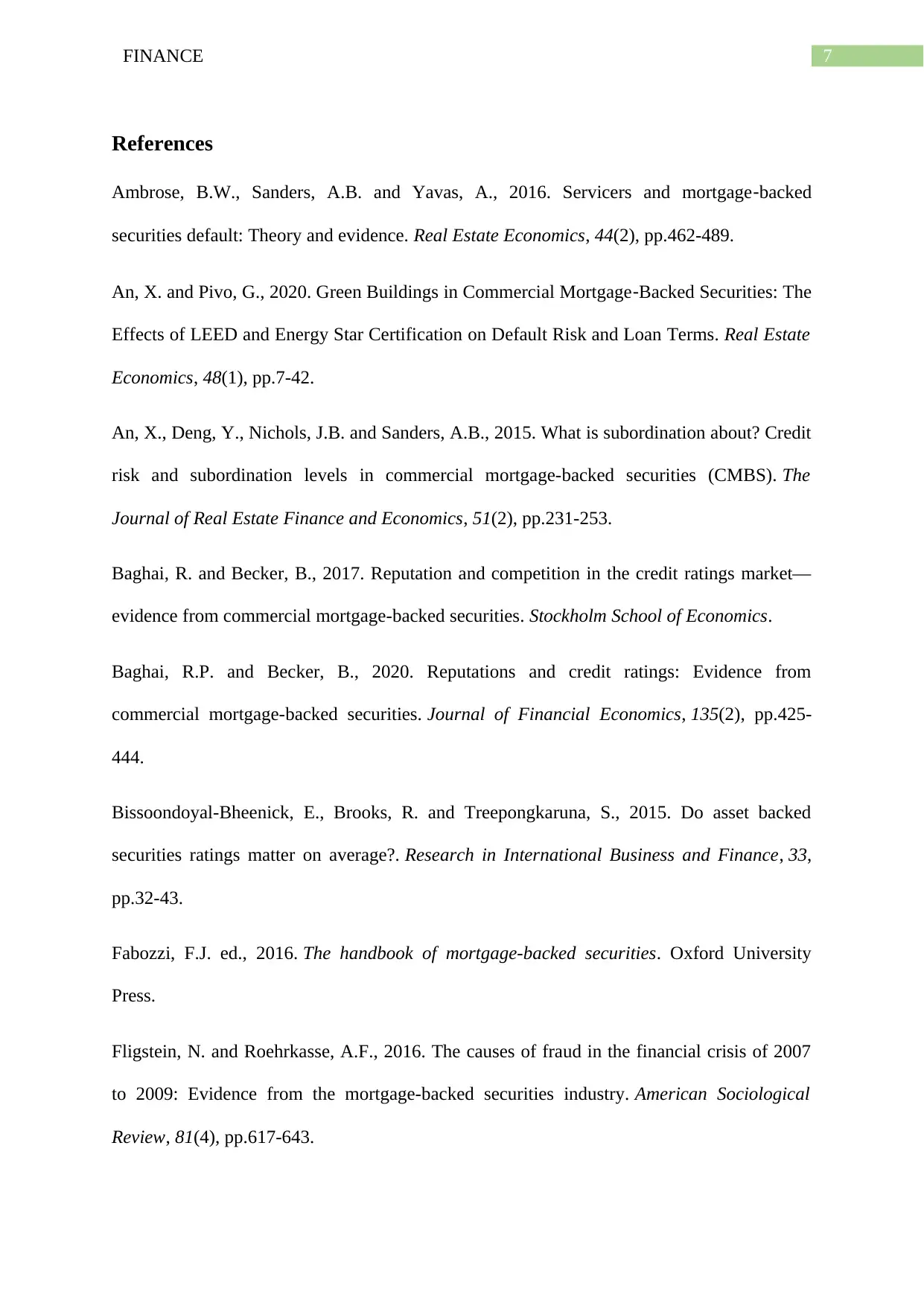
7FINANCE
References
Ambrose, B.W., Sanders, A.B. and Yavas, A., 2016. Servicers and mortgage‐backed
securities default: Theory and evidence. Real Estate Economics, 44(2), pp.462-489.
An, X. and Pivo, G., 2020. Green Buildings in Commercial Mortgage‐Backed Securities: The
Effects of LEED and Energy Star Certification on Default Risk and Loan Terms. Real Estate
Economics, 48(1), pp.7-42.
An, X., Deng, Y., Nichols, J.B. and Sanders, A.B., 2015. What is subordination about? Credit
risk and subordination levels in commercial mortgage-backed securities (CMBS). The
Journal of Real Estate Finance and Economics, 51(2), pp.231-253.
Baghai, R. and Becker, B., 2017. Reputation and competition in the credit ratings market—
evidence from commercial mortgage-backed securities. Stockholm School of Economics.
Baghai, R.P. and Becker, B., 2020. Reputations and credit ratings: Evidence from
commercial mortgage-backed securities. Journal of Financial Economics, 135(2), pp.425-
444.
Bissoondoyal-Bheenick, E., Brooks, R. and Treepongkaruna, S., 2015. Do asset backed
securities ratings matter on average?. Research in International Business and Finance, 33,
pp.32-43.
Fabozzi, F.J. ed., 2016. The handbook of mortgage-backed securities. Oxford University
Press.
Fligstein, N. and Roehrkasse, A.F., 2016. The causes of fraud in the financial crisis of 2007
to 2009: Evidence from the mortgage-backed securities industry. American Sociological
Review, 81(4), pp.617-643.
References
Ambrose, B.W., Sanders, A.B. and Yavas, A., 2016. Servicers and mortgage‐backed
securities default: Theory and evidence. Real Estate Economics, 44(2), pp.462-489.
An, X. and Pivo, G., 2020. Green Buildings in Commercial Mortgage‐Backed Securities: The
Effects of LEED and Energy Star Certification on Default Risk and Loan Terms. Real Estate
Economics, 48(1), pp.7-42.
An, X., Deng, Y., Nichols, J.B. and Sanders, A.B., 2015. What is subordination about? Credit
risk and subordination levels in commercial mortgage-backed securities (CMBS). The
Journal of Real Estate Finance and Economics, 51(2), pp.231-253.
Baghai, R. and Becker, B., 2017. Reputation and competition in the credit ratings market—
evidence from commercial mortgage-backed securities. Stockholm School of Economics.
Baghai, R.P. and Becker, B., 2020. Reputations and credit ratings: Evidence from
commercial mortgage-backed securities. Journal of Financial Economics, 135(2), pp.425-
444.
Bissoondoyal-Bheenick, E., Brooks, R. and Treepongkaruna, S., 2015. Do asset backed
securities ratings matter on average?. Research in International Business and Finance, 33,
pp.32-43.
Fabozzi, F.J. ed., 2016. The handbook of mortgage-backed securities. Oxford University
Press.
Fligstein, N. and Roehrkasse, A.F., 2016. The causes of fraud in the financial crisis of 2007
to 2009: Evidence from the mortgage-backed securities industry. American Sociological
Review, 81(4), pp.617-643.

8FINANCE
Furfine, C.H., 2014. Complexity and loan performance: Evidence from the securitization of
commercial mortgages. The Review of Corporate Finance Studies, 2(2), pp.154-187.
Goodman, L.S., 2016. The rebirth of securitization: Where is the private-label mortgage
market?. The Journal of Structured Finance, 22(1), pp.8-19.
Furfine, C.H., 2014. Complexity and loan performance: Evidence from the securitization of
commercial mortgages. The Review of Corporate Finance Studies, 2(2), pp.154-187.
Goodman, L.S., 2016. The rebirth of securitization: Where is the private-label mortgage
market?. The Journal of Structured Finance, 22(1), pp.8-19.
⊘ This is a preview!⊘
Do you want full access?
Subscribe today to unlock all pages.

Trusted by 1+ million students worldwide
1 out of 9
Related Documents
Your All-in-One AI-Powered Toolkit for Academic Success.
+13062052269
info@desklib.com
Available 24*7 on WhatsApp / Email
![[object Object]](/_next/static/media/star-bottom.7253800d.svg)
Unlock your academic potential
Copyright © 2020–2025 A2Z Services. All Rights Reserved. Developed and managed by ZUCOL.





